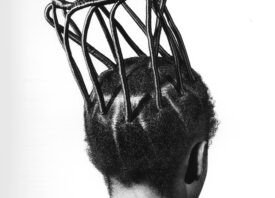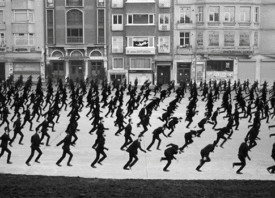Search this site
Mesmerizing Gifs of Traditional Nigerian Women’s Hair Styles


In 2015, Francois Beaurain traveled to Lagos Photo, where he met Medina Dugger. Inspired by the work of late photographer J.D. Okhai Ojeikere and Nigerian hair color trends, they launched Chromatin, an on-going collaboration that transforms Dugger’s photographs of traditional Nigerian women’s hair styles into a series of mesmerizing gifs that are rooted in fractals, the very heart of African design and art.
Fractals are a curve or geometric figure where each part has the same statistical character as the whole, creating a never-ending pattern on an on-going feedback loop. While the West came to understand and name this phenomenon in 1975, fractals have been an integral part of African culture daring back to ancient Egyptian times, and can be seen in cultures in Sub-Saharan Africa writ large.
With the invasion of the continent by Euorpean imperialists for centuries, a great deal of the traditional cultures were destroyed and erased — with the exception of hair braiding. “African hair designs are among the last remaining remnants of an ancient African cultural pillar that has been almost completely annihilated by centuries of colonization and cultural domination,” Beaurain and Dugger note.
With Chromatin, the artists restore fractals to their rightful place: as the fundamental essence of African art and design, and imbue it with a modern twist, combining hair design and digital technology to create a powerful new way of seeing the depth and complexity of traditional African culture and thought. Beaurain speaks with us about making fractals the center of their art.
I love the photographs of J.D. Okhai Ojeikere. Please speak about the impact of his work on the creation of Chromatin.
Francois Beaurain: I discovered his work when I first traveled to Nigeria in 2015, it was one year after his death and there was at that time a renewed interest in his work. I love the precision and completeness of his work, his collection of pictures is somehow encyclopedic. I do not know if there are contemporary photographers who would have the patience/perseverance to do something like that now.
When I came back to Lagos this year for a residency at arthouse foundation, Medina showed me the first shots of Chroma, her photography project about contemporary Nigerian hairstyle inspired by J.D. Okhai Ojeikere. Chromatin is the small brother (or sister) of Chroma, They are not only based on two different mediums but they also have different aims. Chroma is an ode to Ojekere’s work.
Please speak about the significance and use of fractals in African design and art.
Francois Beaurain: Contrary of what most people think, mathematics are not universal; a civilization develops the mathematics they need. In recent decades, ethnomathematicians have started to focus on Africa in search of ancient forms and realized that fractals were used all over Africa for centuries and centuries – even millennia if you consider the ancient Egypt, while they’re almost absent from other continents. (I am excluding the Arabic world when mentioning Africa because its mathematics shares a common ground with Europe).
Africa has discovered and used fractals in many forms long before than any other civilizations: in architecture, fabrics, braiding, and the visual arts. However, although fractals can be found all over Africa, they remain rare. It is not the main element to understand ancient African cultures, but it is an interesting key if you’re looking to analyze pre-colonial African arts.

In the project description, you observe that “Europeans were unable to understand the subtleties of fractals, underscores a limiting, ethnocentric perspective…” Could you expand on this?
Francois Beaurain: The West started to describe fractals just one century ago and at that time, the referred to them as “degenerated shapes.” It is only at the end of twentieth century that, thanks to mathematicians like Mandelbrodt, the West started to conceptualize fractals.
The first Europeans who started to colonize Africa were totally unaware of fractals. They could not imagine that Africa has a knowledge that they could not understand. What I want to point out with this project is that Africa was centuries ahead of Europe with fractals and, that in this specific domain the “primitive” people were the Europeans. Maybe fractals are not the only knowledge that has been neglected by the colonizers. Maybe we will find others in the future.
How did fractals in hair design survive, when so many other practices disappeared?
Francois Beaurain: The colonizers has not only taken the land and the resources, it has also colonized the minds. Europeans have imported their religions, languages, schools, and their mathematics. In this context, I think only cultural forms at the margin of society could survive. African braiding techniques are transmitted through generations of women. This mother-daughter bond might have allowed braiding techniques to survive centuries of colonization.

What inspired you to add the layer of motion to the work?
Francois Beaurain: I am a former scientist and I used to study physics. When I was at the university, I had the chance study Chaos Theory, which includes basic knowledge of fractals. It was a fascinating class but completely useless in my work and in every day’s life. During my first visit to Lagos, I noticed some hairdos with fractals patterns – and this made me thing about what I learned at the university 20 years ago. One day, I Googled “Fractal + Africa” and found the work of Ron Elgash, who wrote the book African Fractals in 1999.
Around the same time, Medina introduced me to Chroma. Our initial goal with Chromatin was to play with the geometry of the haircuts Medina was photographing, but the more I was learning about African fractals, the more I was tempted to introduce this kind of pattern in my animations.
Please speak about the significance of color in these works?
Francois Beaurain: The color is all on Medina’s side. She’s the one who decides the haircuts, the background, et cetera. She is inspired by the latest trends in African hairstyles, which has followed the availability of colorful extensions in local markets.
In America, people are more inclined to say: “It’s just hair,” whether talking about weave, perms, or natural styles. Does this same philosophy hold true or are there underlying meanings or statements within each design?
Francois Beaurain: In Medina’s statement about Chroma, she explains, “Hairdos range from being purely decorative to conveying deeper more symbolic understandings, revealing social, status, age and tribal/family traditions.”
Behind the simplicity of these everyday hairstyles, there are some hidden meanings. Unfortunately the meanings of fractals have disappeared. There are no written traces or testimonies on how to interpret fractals in African cultures. They are a few theories but it’s very shaky. For example, the interpretation that fractal is the geometry of nature and because Africans are closer to Nature is most probably wrong. Interpreting fractals as a metaphor of the cycle of life, traducing an endless cycle (rather than a linear) interpretation of time could be an answer. This has not been proven but I like this explanation. I find it elegant.


All artworks: From Chromatin, © Francois Beaurain and Medina Dugger.



